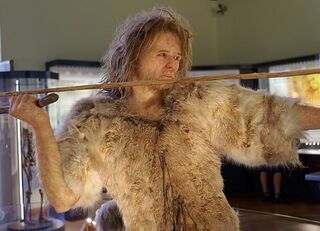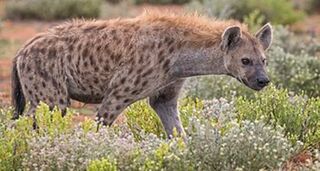Genetics
New Views of Neanderthal Are Reshaping Prehistory
New evidence of Neanderthal society helps reveal humanity’s place in the world.
Posted December 11, 2022 Reviewed by Abigail Fagan
Key points
- Neanderthals have long been portrayed as dullards who survived the Ice Age through animalistic tendencies alone.
- New research into their lives challenges that understanding.
- Neanderthals cooked food, captured and kept raptors, and could have cooperatively hunted with them.
- Understanding new developments in Neanderthal studies allow us to challenge our beliefs about ourselves and our place in nature today.
In the last decade of the last millennium, I began investigating our near, extinct cousin Homo neanderthalensis, or to those who thought him too feeble to stand as a species, H. sapiens neanderthalis.
Many of the top experts in the field described Neanderthals as thick-headed cave dwellers who lacked speech and fire—not to mention proper clothing—and thus, survived in the bitter cold of the last Ice Age on the strength, one supposes, of their brutish animal nature.

This view was by no means universal, and it had already begun to crumble in the face of solid archaeological evidence when Svante Pääbo isolated and analyzed Neanderthal’s genome in 2009—for which work he was awarded the 2022 Nobel Prize in Physiology or Medicine. Since then, it seems, each month brings a new report of a Neanderthal talent or action that leaves yesterday’s experts scratching their heads in wonder, if not disbelief. Inevitably, the dates for these activities are shifted back in time so that they show the many adaptations Neanderthals made to their circumstances.
For instance, Neanderthal appears to have mastered and used fire for a variety of purposes including cooking after their appearance in Eurasia some 300,000 or more years ago. They also made carvings into ivory, and they almost certainly communicated using speech. To show how slowly attitudes change, I have recently seen people speculate that Neanderthal may have only seasonally had fire, but in general were incapable of igniting tinder on their own. This view recently received what would appear to be a mortal blow when Ceren Kabukcu and colleagues revealed that Neanderthal not only had fire throughout the year, but also used fire to cook a wide variety of foods which they consumed.
More recently, Laurits Skov et al. explored the social structure of Neanderthal as revealed through the genomes of an adult male and a female, apparently his daughter. The authors of this work assert that Neanderthals, at least those in the Altai mountain region, traveled upon marriage to their husband’s family group. Yet this flow of women may have been insufficient to ensure the genetic diversity of Neanderthals in general because the numbers involved had become small—if they were ever large. Inbreeding became a problem, which may have been solved in some areas by repeated cross-mating between Neanderthals, Denisovans, and early Homo sapiens. Such cross-breeding can cause its own problems by diluting the gene pool for both or either species. Whether these were voluntary unions or the result of rape, we don’t know. The upshot of all of this mixing appears to be that today, 1-2% of the genes of people who live outside sub-Saharan Africa derive from Neanderthals, while the recently identified Denisovans account for up to 4-6% of the genetic material in some Southeast Asians and Pacific Islanders.

Elsewhere, we have learned that Neanderthal captured golden eagles and other raptors, presumably to take their talons and feathers for use in various rituals and decorative objects. According to Stewart Finlayson et al., the Neanderthals “selectively took the largest raptors at their disposal within Eurasia,” which turned out to be the golden eagle, with regional and local exceptions. Whether they hunted with golden eagles is not known, but given the time and effort they spent collecting them, it is not unimaginable that they did not at least make an attempt to tame them. If this is true, it would represent the use by hominins of another species for a specific purpose like hunting that would be far earlier than the current earliest meeting of wolves and humans. This raised in my mind the date of 135,000 years ago of the first genetic appearance of the dog from the wolf offered by Bob Wayne and Carles Vila.
So I decided to ask around to see what the current thinking is regarding Neanderthal and the arrival in our midst of dogs—ignoring, for now, the questions of precisely where, when, and how that occurred. After all, if Neanderthal was involved, all bets would be off regarding current theories of wolf-to-dog evolution. Greger Larson, who directs the international collaborative effort to answer those questions, referred me to Mietje Germonpré, of the Royal Belgian Institute of Natural Sciences. Her response was detailed and generous.

The question was whether Neanderthals could have formed any bonds or made use of wolves or early wolf-dogs. Germonpré offered in an email to me that “archeological evidence suggests that modern humans had a special interest in canids, while such an interest seems absent in Neanderthals,” who did nonetheless have rich interactions with a variety of other carnivores, including bears, raptors, and hyenas. Hyenas and Neanderthals appear to have had an especially extensive relationship, the boundaries of which are unknown. One might ask whether hyenas were Neanderthals’ “dogs.” Upper Paleolithic sites reveal, in contrast with Middle Paleolithic sites, large quantities of personal objects made from canid teeth, especially from foxes, wolves, and bears. Researchers have suggested that early modern humans were using these canids to provide fur trim for their clothing, which Neanderthals did not have; they seem to have preferred capes.
This question of the relationship between hominins and carnivores is part of an emerging field of study, which finds its parallels in the study of our place in the world in relation to other non-human animals, and to nature itself. The purpose of this multispecies approach to the distant past, as well as the near present, is based on the recognition that humans and their forebears live in the world and are shaped by it, just as they shape it. The fact is, we may be unique, but we are not special. That, of course, raises the question of why a species seemingly as vital as Neanderthal might have vanished, save for the bits and pieces of their genetic material that managed to slip through the jaws of extinction.
---
12/13/22 Minor corrections have been made.
Editorial assistance provided by Daniel Elliott.
References
Ceren Kabukcu, et al, “Cooking in caves: Palaeolithic carbonised plant food remains from Franchthi and Shanidar,” Antiquity 1 (2022). DOI: https://doi.org/10.15184/aqy.2022.143.
Svante Pääbo, Facts. https://www.nobelprize.org/prizes/medicine/2022/paabo/facts/
Laurits Skov, et al, “Genetic insights into the social organization of Neanderthals,” 610 Nature 519 (19 Oct 2022). DOI: https://doi.org/10.1038/s41586-022-05283-y.
Stewart Finlayson, et al, “Neanderthals and the cult of the Sun Bird,” 217 Quaternary Science Review 217 (August 2019). DOI: https://doi.org/10.1016/j.quascirev.2019.04.010.
Mark Collard, et al, “Faunal evidence for a difference in clothing use between Neanderthals and early modern humans in Europe,” 44B Journal of Anthropological Archeology 235 (December 2016). DOI: https://doi.org/10.1016/j.jaa.2016.07.010.
Shumon T. Hussain, et al, “Being-with other predators: Cultural negotiations of Neanderthal-carnivore relationships in Late Pleistocene Europe,” 66 Journal of Anthropological Archeology 101409 (June 2022). DOI: https://doi.org/10.1016/j.jaa.2022.101409.


